
A seahorse is any of 46 species of small marine bony fish in the genus Hippocampus. "Hippocampus" comes from the Ancient Greek hippókampos (ἱππόκαμπος), itself from híppos (ἵππος) meaning "horse" and kámpos (κάμπος) meaning "sea monster" or "sea animal". Having a head and neck suggestive of a horse, seahorses also feature segmented bony armour, an upright posture and a curled prehensile tail. Along with the pipefishes and seadragons they form the family Syngnathidae.

Mysida is an order of small, shrimp-like crustaceans in the malacostracan superorder Peracarida. Their common name opossum shrimps stems from the presence of a brood pouch or "marsupium" in females. The fact that the larvae are reared in this pouch and are not free-swimming characterises the order. The mysid's head bears a pair of stalked eyes and two pairs of antennae. The thorax consists of eight segments each bearing branching limbs, the whole concealed beneath a protective carapace and the abdomen has six segments and usually further small limbs.

The Syngnathidae is a family of fish which includes seahorses, pipefishes, and seadragons. The name is derived from Ancient Greek: σύν, meaning "together", and γνάθος, meaning "jaw". The fused jaw is one of the traits that the entire family have in common.

Hippocampus angustus, commonly known as the narrow-bellied seahorse, western Australian seahorse, or western spiny seahorse, is a species of marine fish of the family Syngnathidae. It is found in waters off of Australia, from Perth to Hervey Bay, and the southern portion of Papua New Guinea in the Torres Strait. It lives over soft-bottom substrates, adjacent to coral reefs, and on soft corals at depths of 3–63 metres (9.8–206.7 ft). It is expected to feed on small crustaceans, similar to other seahorses. This species is ovoviviparous, with males carrying eggs in a brood pouch before giving birth to live young. This type of seahorse is monogamous in its mating patterns. The males only fertilize one female's eggs for the mating season because of the population distribution. While some seahorses can be polygamous because they are denser in population, this type of seahorse is more sparsely distributed and the cost of reproduction is high. Therefore, the risk to reproduce due to predatory and distributary factors limits this breed to one mate, often finding the same mate season after season.

Barbour's seahorse is a species of fish of the family Syngnathidae.

The knobby seahorse, also known as the short-headed seahorse or short-snouted seahorse, is a species of marine fish of the family Syngnathidae. It inhabits coastal waters in southwestern and southeastern Australia, from Gregory to Bremer Bay, and from Denial Bay to Newcastle.

Hippocampus coronatus, commonly known as the high-crowned seahorse or crowned seahorse, is a species of fish of the family Syngnathidae. It is endemic to the Pacific coastal waters of Japan, where it lives among Zostera seagrasses. It can grow to lengths of 10.8 centimetres (4.3 in), but is more commonly 6 centimetres (2.4 in). Individuals feed mainly on small crustaceans such as gammarid amphipods and copepods, although this can vary by size, with smaller individuals consuming copepods while larger individuals feed on amphipods and mysids. This species is ovoviviparous, with males brooding eggs in a brood pouch before giving birth to live young. Breeding season occurs from June to November, with females and males reaching sexual maturity at 6.9 centimetres (2.7 in) and 7.3 centimetres (2.9 in) respectively. Male brood size ranges from 12–46. The International trade in this species has been monitored through Appendix II of the CITES licensing system since 2004 and a minimum size of 10 centimetres (3.9 in) applies to traded specimens.

The Pacific seahorse, also known as the giant seahorse, is a species of fish in the family Syngnathidae. Their genus name (Hippocampus) is derived from the Greek word hippos, which means "horse" and campus, which means "sea monster." This species is the only seahorse species found in the eastern Pacific Ocean.
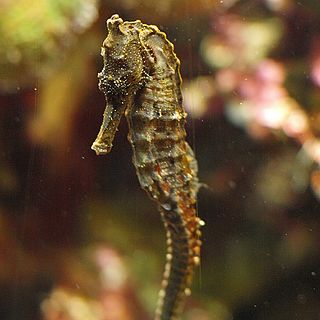
The great seahorse, also known as Kellogg's seahorse is a species of fish in the family Syngnathidae. It is one of the largest of the 54 species of seahorse.

Hippocampus kuda is a species of seahorse, also known as the common seahorse, estuary seahorse, yellow seahorse or spotted seahorse. The common name sea pony has been used for populations formerly treated as the separate species Hippocampus fuscus, now a synonym of H. kuda.

The slender seahorse or longsnout seahorse is a species of fish in the family Syngnathidae that usually inhabits subtropical regions.

The hedgehog seahorse is a species of fish of the family Syngnathidae. It inhabits coastal waters from India and Sri Lanka to Taiwan and northern Australia. It is threatened by overfishing, as both targeted catch and bycatch. This species is ovoviviparous, with males carrying eggs in a brood pouch before giving birth to live young.
The false-eye seahorse, or flatface seahorse is a species of marine fish of the family Syngnathidae. It is endemic to Australia, from Shark Bay to Broome, where it is found in intertidal rockpools, shallow algae and weedy or rubble reef habitats. It is expected to feed on harpacticoid, calanoid, and cyclopoid copepods, caridean and gammaridean shrimps, and mysids, similar to other seahorses. This species is ovoviviparous, with males brooding eggs in a brood pouch before giving birth to live young.

Hippocampus whitei, commonly known as White's seahorse, New Holland seahorse, or Sydney seahorse, is a species of marine fish of the family Syngnathidae. It is thought to be endemic to the Southwest Pacific, from Sydney, New South Wales and southern Queensland (Australia) to the Solomon Islands. It lives in shallow, inshore habitats, both natural and anthropogenic. This species is ovoviviparous, with males brooding eggs in a brood pouch before giving birth to live young.
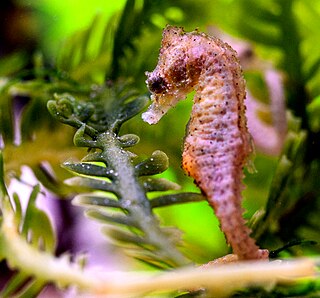
The dwarf seahorse is a species of seahorse found in the subtidal aquatic beds of the Bahamas and parts of the United States. It is threatened by habitat loss. According to Guinness World Records, it is the slowest-moving fish, with a top speed of about 5 feet (1.5 m) per hour.
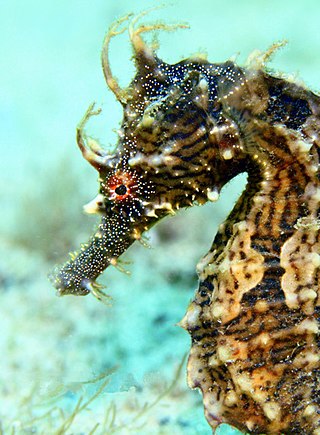
The lined seahorse, northern seahorse or spotted seahorse, is a species of fish that belongs to the family Syngnathidae. H. erectus is a diurnal species with an approximate length of 15 cm and lifespan of one to four years. The H. erectus species can be found in myriad colors, from greys and blacks to reds, greens, and oranges. The lined seahorse lives in the western Atlantic Ocean as far north as Canada and as far south as the Caribbean, Mexico, and Venezuela. It swims in an erect position and uses its dorsal and pectoral fins for guidance while swimming.
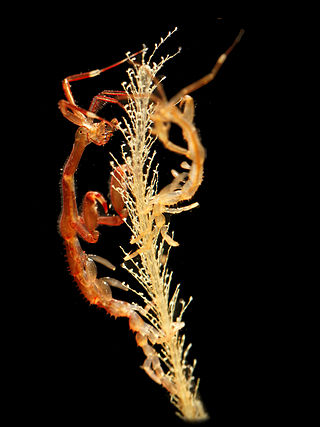
Caprella mutica, commonly known as the Japanese skeleton shrimp, is a species of skeleton shrimp. They are relatively large caprellids, reaching a maximum length of 50 mm (2.0 in). They are sexually dimorphic, with the males usually being much larger than the females. They are characterized by their "hairy" first and second thoracic segments and the rows of spines on their bodies. Body color ranges from green to red to blue, depending on the environment. They are omnivorous highly adaptable opportunistic feeders. In turn, they provide a valuable food source for fish, crabs, and other larger predators. They are usually found in dense colonies attached to submerged man-made structures, floating seaweed, and other organisms.
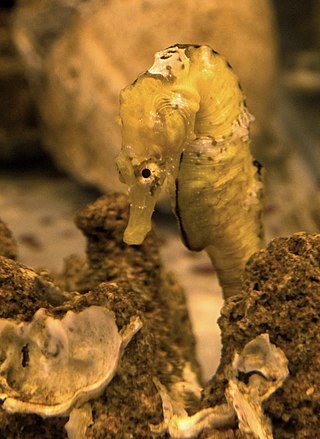
The Patagonian seahorse is a species of marine fish of the family Syngnathidae. It inhabits coastal waters from northeastern Brazil to Chubut, Argentina. It generally is found at shallow depths attached to natural or artificial substrates. This species is ovoviviparous, with males brooding eggs in a brood pouch before giving birth to live young.
Hippocampus dahli is a fish species of the family Syngnathidae. It is endemic to the Australian northeastern coast, from Darwin to Brisbane, where it inhabits estuarine channels and rubble or soft substrates to depths of 21 metres (69 ft). Little is known of its feeding habits, but it is likely to feed on small crustaceans such as copepods, amphipods, and gammarid, caprellid, and caridean shrimps, similar to other seahorses. This species is ovoviviparous, with males carrying eggs in a brood pouch before giving birth to live young. This species is not listed in FishBase and many authorities treat it as a synonym of Hippocampus trimaculatus.

Urocampus nanus, commonly known as the barbed pipefish, is a species of marine fish belonging to the family Syngnathidae. This family consists of 56 different genera and 320 species.


























